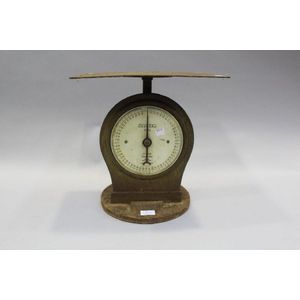Polychrome Jesus Figure with Ivory Face and Glass Eyes
A carved wood & polychrome figure of Jesus, an ivory face inlaid with glass eyes, shoulder length hair, 18th/19th century, the cloak draped over the right shoulder & swirling diagonally across the body, wearing a large circular breast plate on a chain, standing on a square stand carved as part of the figure, red pigment under the black, condition: Appropriate age wear, one glass eye & both hands missing, a fine patina, height 27 cm, length 10 cm
You must be a subscriber, and be logged in to view price and dealer details.
Subscribe Now to view actual auction price for this item
When you subscribe, you have the option of setting the currency in which to display prices to $Au, $US, $NZ or Stg.
This item has been sold, and the description, image and price are for reference purposes only.
- Polychrome - Made or finished in many colours. For furniture, it is used to indicated a painted finish.
- Patination / Patina - In broad terms, patination refers to the exterior surface appearance of the timber, the effect of fading caused by exposure to sunlight and air over the course of a century or more, changing the piece to a soft, mellow colour.
As patina is very difficult to replicate, it is one of the most important guides to determining the age of furniture.
Patina is also the term applied to the bloom or film found on old bronzes due to oxidisation. - Ivory - Ivory is a hard white material that comes from the tusks of elephants, mammoth, walrus and boar, or from the teeth of hippopotamus and whales. The ivory from the African elephant is the most prized source of ivory. Although the mammoth is extinct, tusks are still being unearthed in Russia and offered for sale.
Ivory has been used since the earliest times as a material for sculpture of small items, both in Europe and the east, principally China and Japan.
In Asia ivory has been carved for netsuke, seals, okimono, card cases, fan supports, animals and other figures and even as carved tusks.
In the last 200 years in Europe ivory has been used to carve figures, for elaborate tankards, snuff boxes, cane handles, embroidery and sewing accessories, in jewellery and as inlay on furniture. Its more practical uses include being used for billiard balls, buttons, and a veneers on the top of piano keys.
The use and trade of elephant ivory have become controversial because they have contributed to Due to the decline in elephant populations because of the trade in ivory, the Asian elephant was placed on Appendix One of the Convention on International Trade in Endangered Species (CITES), in 1975, and in January 1990, the African elephant was similarly listed. Under Appendix One, international trade in Asian or African elephant ivory between member countries is forbidden. Unlike trade in elephant tusks, trade in mammoth tusks is legal.
Since the invention of plastics, there have been many attempts to create an artificial ivory
This item has been included into following indexes:
- religious objects, Christian
Visually similar items

An antique mahogany ship's saloon swivel chair with side arms and turned spindle back. Supported on a painted green cast iron four legged base salvaged from the SS Wiltshire, March 8th 1923. Fabric seat. Height 89 cm
Sold by
in
for
You can display prices in $Au, $US, $NZ or Stg.

Set of Salter scales, no. 65, 56lbs, 37 cm high
Sold by
in
for
You can display prices in $Au, $US, $NZ or Stg.

9ct gold and ruby ring weight: approx 2.7 grams, size:P-Q/8
Sold by
in
for
You can display prices in $Au, $US, $NZ or Stg.

A blanc-de-Chine figure of Guanyin with attendants, 26 cm high
Sold by
in
for
You can display prices in $Au, $US, $NZ or Stg.
